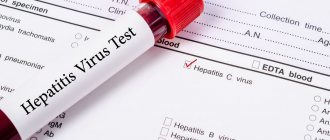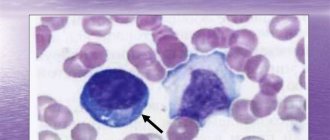To select effective therapy, it is necessary to conduct research, among which tumor markers for women are mandatory. Thanks to antigen testing, early detection of serious diseases is possible, which increases the chance of cure. The analysis is carried out not only to diagnose cancer, the determination of the marker is also used to determine the effectiveness of anti-cancer therapy.
An increasing number of women are faced with cancer, including neoplasms not only of the reproductive system, but also tumors of other organs - mammary glands, lungs, liver and kidneys.
What does a blood test for tumor markers indicate?
An elevated level of indicators may indicate a long-term pathological process. These results help in monitoring and diagnosing cancer. If a person knows which tumor markers to test for prevention, then if a positive result is detected, the presence of a tumor can be diagnosed at an early stage. Then treatment of the disease will be much more effective.
Tumor markers are molecules that constantly circulate in the blood. Most often, their presence indicates the presence of cancer. But their increased content does not always indicate that a person has cancer. Tumor markers can indicate inflammatory processes in the body that occur in the liver, kidneys, pancreas and other organs. Also, these protein structures are detected in certain emotional states of the patient. However, if the test for tumor markers is positive, this is always a reason for additional examination.
Indications for the study
Tumor marker tests are not carried out during preventive examinations.
Testing for tumor markers is required for women with the following indications:
- Suspicion of the presence of a malignant neoplasm in the woman’s body. If an instrumental examination reveals a pathological formation, then this blood test is prescribed;
- The presence of pathological symptoms that indicate a malignant tumor (severe weakness, significant weight loss, lack of appetite, pain, uterine bleeding, menstrual irregularities, and others). It should be taken into account that cancer of the reproductive system is asymptomatic for a long time. Obvious signs are detected in the later stages of the disease;
- Monitoring the treatment;
- Study of women at risk;
- Early detection of cancer recurrence and spread of metastases. For this purpose, all women who have undergone successful treatment undergo this analysis once every 3 months, six months or a year.
Preparing for analysis
It is necessary to clarify that this procedure must be taken very seriously. If the patient does not adhere to the rules, the result may be erroneous and the analysis will have to be retaken. Therefore, doctors advise following the following recommendations to ensure that the results of tumor markers are correct:
- A week before the expected date of testing, it is advisable to remove chips, crackers, store-bought juices, sweet soda, as well as smoked fish and sausages from your diet. All of the above products contain dyes, stabilizers and artificial flavor enhancers. If they are in the blood in large quantities, they can provoke an incorrect result.
- Before taking the test, you need to bring your psycho-emotional state back to normal. If the patient is under stress, certain hormones are released. They also affect the appearance of protein structures in the blood. Therefore, before starting blood sampling, you need to have a good rest and not be nervous.
- To obtain correct tumor marker results, it is necessary to temporarily eliminate smoking and alcohol.
- Three days before the appointed date, you must stop taking any pharmaceuticals, herbal teas, infusions and decoctions.
- It is required to take tests from 8-00 to 12-00. The procedure must be carried out on an empty stomach. You can only drink a glass of water without gas or additives.
How is the analysis carried out, what are the indications for its use?
Blood sampling for testing is carried out in the morning on an empty stomach.
When preparing to take a tumor marker test, always follow the recommendations of the doctor who gave you the referral. Blood from a vein is used as a biological material for this study. General recommendations for preparing for testing for cancer markers are as follows:
- If there are signs of any inflammatory process or menstruation, be sure to inform your doctor about them, since under the influence of these factors, the analysis parameters may be increased, and the study will be uninformative. In such cases, it is better to take the analysis 5-6 days after the inflammatory process has resolved or after the end of menstruation.
- Avoid drinking alcoholic beverages 24 hours before the test.
- It is better to donate blood in the morning, since the biomaterial must be collected on an empty stomach (at least 8 hours must pass after the last meal).
- Tests for tumor markers - the main principle of this study is to take a series of tests on blood samples - it is better to take them in the same laboratory, since different reagents for performing them have different sensitivities, and it will be difficult for the doctor to monitor the results.
- Remember that only a doctor can correctly evaluate test results.
Test results can be obtained 1-2 days after donating blood.
The frequency of testing is determined by the doctor individually for each patient. As a rule, those patients who have undergone radical cancer treatment are recommended to undergo such a study once every 3-4 months.
Indications
Monitoring the level of tumor markers is indicated:
- in the presence of unfavorable heredity (i.e., if several family members are diagnosed with cancer of a certain location);
- if it is necessary to clarify the diagnosis (in combination with other methods of diagnosing tumors);
- if necessary, monitor the effectiveness of treatment of oncological pathologies;
- if necessary, to prevent tumor recurrence after treatment.
What tumor markers should a woman take?
For the prevention and detection of diseases, only specific indicators are used that can make it possible to identify oncology. You need to know that all tumor markers are extremely sensitive to any inflammatory processes. Therefore, if at least one source of infection is present in the body, tests can show the presence of cancer cells. For the result to be correct, it is initially necessary to undergo an inpatient examination and completely exclude chronic ailments.
Main tumor markers:
- “CA-15–3 and MSA” are intended to detect malignant tumors in the breast. Also, using these indicators, the absence or presence of metastases is determined.
- Decoding the tumor marker “CA-125” shows the presence or absence of ovarian cancer. Also, this protein structure occurs in increased quantities during pregnancy. Therefore, if “CA-125” is positive, then additional examinations are carried out.
- “CA-72–4” - this type is used in cases where there is a suspicion of ovarian cancer, when you need to be completely sure that the treatment is being carried out correctly, and also to confirm the gradual destruction of malignant cells.
- HCG in women helps diagnose uterine cancer. Thanks to the test, pathological abnormalities can be identified at an early stage. In addition, such an analysis is used to re-diagnose the disease in uterine tissue after surgery.
Indications for blood testing for tumor markers
Antigens come in different forms. Forms are known that can detect cancer at the stage of formation. Selected species give positive results only when monitored with other diagnostic procedures.
Key indicators for using a tumor marker:
- A woman over 35 years of age should donate blood annually for prevention.
- For men, the doctor recommends testing after 50 years every 12 months.
- Children need analysis to monitor the process of treatment of cancer or if cancer is suspected.
- Patients with pathology regularly donate blood to learn the results of the therapy.
After recovery, a person must be systematically tested so that the doctor has the opportunity to monitor tumor markers and detect a relapse of the disease at the initial stage.
Doctors consider PSA an accurate and necessary marker. The study is often prescribed to confirm the diagnosis of oncology.
What tumor markers should a man take for prevention?
All of the tests mentioned below (if performed correctly) help detect the presence of malignant cells several months before they are detected by standard diagnostic methods.
Main tumor markers:
- "AFP" - makes it possible to determine the presence of pathological changes in the male testicles.
- PSA is a male tumor marker used to detect prostate cancer. It is also used to diagnose chronic inflammation in a given area of the body, which helps provide timely treatment.
When these indicators increase significantly, this is the first sign of the presence of cancer.
Thyroid cancer
As already mentioned, a tumor marker is a protein secreted by cancer cells and some healthy cells. It is found in both urine and blood. For thyroid cancer, blood is donated for the following tumor markers:
- "Calcitonin" - may be present in the patient's blood or urine. Used in the diagnosis of modular cancer. Its concentration depends on the formation and period of the pathological process.
- “Thyroglobulin” is a protein that collects in the follicles of the thyroid gland. It is the main marker in the diagnosis of relapse of malignant tumors.
- “CEA” (carcinoembryonic antigen) – with thyroid disease, the tumor marker increases. It is determined only in blood serum.
Tests for suspected bowel cancer
All tumor markers known today can be divided into two groups:
- Specific. They indicate that an oncological process is definitely present in the body and help determine its type.
- Nonspecific - show the possible presence of an oncological process, but may also indicate that there is inflammation of an organ in the body in the absence of oncology.
The specific ones include:
- CEA is a tumor marker used to diagnose problems in the large intestine and rectum. If it is present in the analysis, it is possible to predict the further dynamics of the tumor, obtain the necessary information about the parameters of the malignant neoplasm and establish the period of growth.
- “CA 242” indicates pathology of the large intestine, pancreas and rectum at fairly early stages. Based on the results of this examination, tumor formation can be predicted 3–5 months in advance.
- “CA 72-4” is a tumor marker whose name is known to many laboratory technicians. It is surrendered together with REA. If antibodies are present, this indicates damage to the cells of the lungs and colon during the formation of small cell cancer.
- “M2-RK” this marker reflects metabolic processes in cancer cells. Its main feature is the lack of specificity when examining organs, which is why it is called a “marker of choice.” The test is used as a special metabolic indicator, since this tumor marker for intestinal cancer indicates the disease in the early stages.
Non-specific ones include:
- "AFP" (alpha fetoprotein) - demonstrates the presence of a neoplasm in the sigmoid and rectum.
- “CA 19–9” - (carbohydrate antigen) identifies pathology that is located in the pancreas, esophagus, gall bladder and ducts of the large intestine.
- The interpretation of the tumor marker “CA 125” in this case indicates the presence of an oncological process in the sigmoid colon. It should be noted that this marker is more often used for female ailments. It is often detected during inflammation in the peritoneum, in the presence of ovarian cysts, and during menstruation.
- “CYFRA 21-1” - an increased amount of this protein indicates problems in the rectum.
- “SCC” is an indicator indicating damage to the rectal canal by an oncological tumor.
- “LASA-P” - the presence of an increased number of this marker notifies about a malignant neoplasm in the intestinal organs.
Decoding the results
Detection of oncology and deciphering the results are always performed only by an experienced specialist. What is important here is accuracy in conducting the examination and choosing the necessary analysis for cancer markers in the body.
Each type of tumor marker reveals an acceptable standard, deviation from which indicates the presence of the disease:
- The tumor marker CEA is a glycoprotein that belongs to carcinofetal antigens formed during fetal development. A high concentration of this tumor marker indicates the appearance of a tumor in the ovaries, lungs, and rectum. It is impossible to decipher the analysis using CEA alone, so the patient is prescribed additional examinations.
- The tumor marker AFP is quantitative; it is present in small quantities in the blood of every person. Its amount becomes sharply higher with the appearance of cancerous tumors and at the time of pregnancy. Also, the amount of this type becomes higher with tumors in the genital organs in men, genital organs in women and the liver. The number of tumor markers becomes higher with metastases in the liver.
- CA 19-9 is a sialoglycoprotein produced in the digestive system; saliva is needed to detect a malignant tumor in the pancreas. Also, a large amount of this tumor marker indicates pathology of the stomach and female genital organs. A slight increase in the CA 19-9 value indicates hepatitis, cholecystitis, problems with the gallbladder, and autoimmune pathologies.
- CA 72-4 is a tumor marker that is used to detect malignant pathology in the stomach. Many people have this tumor marker in their blood cells. A high CA 72-4 value is not always the main indicator of cancer. To establish an accurate diagnosis, some additional studies are prescribed.
- CA 15-3 is a tumor marker used only to identify tumors in women. Its increased amount indicates a malignant formation in the mammary gland. A high value can also appear with a cyst. The advantage of this test is that cancer is diagnosed, detected at the very beginning of its appearance and can be treated. Also, an increase in the amount of tumor markers may indicate tuberculosis or liver cancer.
- CA 125 is a glycoprotein used to detect metastases. A blood test for this tumor marker is prescribed at the time of diagnosing an ovarian tumor and to assess the quality of therapy. A high value of this tumor marker also occurs with the appearance of pathology in the pelvis, hepatitis, and during menstruation. Also, a slight increase in the CA 125 value may appear in the first half of pregnancy.
- SCC is a tumor marker for squamous cell carcinoma of various locations. Its quantity is determined to evaluate the effectiveness of therapy and identify tumor formations in the cervix and nasopharynx. In the absence of oncology, the number of SCC can also increase in asthma and gallbladder pathology.
- HCE appears in neuroendocrine cells; its value may be higher in various pathologies of the central nervous system and ischemic diseases of the brain. A high HCE number indicates formation in the lungs and bronchi. Its moderate increase indicates non-oncological diseases.
- CYFRA 21-1 is an antigen characterized by low specificity and appears in different types of cancer. Combined tests will help accurately determine the inflammatory focus. If the diagnosis is confirmed, then based on the results of the analysis it will be possible to judge the size of the tumor and the prevention of metastases. An increase in the value of a tumor marker indicates pathology, which makes it possible to determine not only the presence of a tumor, but also to monitor its development. Tests during treatment provide information about its effectiveness, since a low level of tumor marker after surgery is a successful treatment.
- HCG is a tumor marker that is formed on the 5th day after fertilization and indicates the normal course of pregnancy. This tumor marker consists of alpha and beta subunits. An increase in the value of the latter confirms pregnancy 7 days after fertilization. In non-pregnant women, an increase in this tumor marker in the blood indicates formations that are produced by the hormone. These include cancer of the kidneys, lungs, and gastrointestinal tract.
- PSA is a protein produced by the cells of the male genital organs and serves as a tumor marker for prostate tumors. Indications for analysis are monitoring the progression of prostate formation and the appearance of metastases. Also, an increase in the values of this tumor marker in the blood indicates various inflammations in the body and injuries. An even higher value of this tumor marker occurs after sexual intercourse and with spastic constipation.
- b-2 is a tumor marker, an increase in the value of which confirms a malignant formation in the kidneys. This is a low molecular weight glycoprotein. An increase in the concentration of this tumor marker indicates various oncological diseases of the blood system, some forms of lymphoma. Also, an increase in the value of this tumor marker can occur in case of renal failure; in especially severe cases, it can accumulate in organs and provoke amyloidosis. The advantage of this marker is that it quickly responds to changes in the course of the disease. Therefore, it is successfully used to monitor the effectiveness of antitumor therapy. If there is no decrease in b-2 after chemotherapy, then it is necessary to stop therapy and prescribe other medications.
Tumor markers for prevention
Everyone knows that preventing cancer is much more important than treating the disease once it has started. Tumor marker tests help diagnose cancer before characteristic symptoms appear. Most often, indicators begin to increase six months before the appearance of metastases. Men over forty years old should definitely monitor their health and donate blood for PSA, as this test helps determine cancer in the prostate gland. Slightly elevated CA-125 values may be a sign of a benign tumor, and results 4-6 times higher than normal indicate a malignant tumor.
What tumor markers should I test for prevention? Here is their list:
- For gastrointestinal problems, a blood test for “CA 15-3” is performed. Persons over 50 years of age are at risk for this type of pathological formation.
- “Thyroglobulin” is a tumor marker for the thyroid gland to identify pathology in it. A large accumulation of this protein may indicate the development of metastases, as well as the fact that there are thyroid antibodies in the blood. The level of “calcitonin” shows the size and speed of development of the pathology.
- To diagnose problems in the liver and gastrointestinal tract, the tumor marker “AFP” is used, which in half of the patients increases 3 months before the onset of the initial symptoms of the pathology. To further confirm the diagnosis, it is necessary to take tests for proteins “CA 15-3”, “CA 19-9”, “CA 242”, “CA 72-4”.
- To check the lungs for malignant tumors, “NSE” is taken. This indicator can be present in nerve cells and in the brain. If elevated values are recorded, the person has cancer.
- Many people should know what tumor markers to test for pancreatic cancer prevention, since this is a very common disease. Doctors often prescribe tests for CA 19-9 and CA 242. If you determine only the last indicator, you can make a mistake in the diagnosis, since “CA 242” may increase due to a cyst, pancreatitis or other formations. Therefore, an analysis for “CA 19-9” is added to the diagnosis.
- To study the kidneys, there is a metabolic test “M2-RK”. This indicator helps determine how aggressive the tumor is. It differs from others in that it has an accumulation effect. An increase in this indicator may indicate oncology of the gastrointestinal tract and breast.
- When diagnosing the bladder, it is recommended to take a UBC test. It can show the presence of cancer in the early stages in 70% of cases. To confirm the accuracy of the diagnosis, you need to additionally pass NMP22.
- In the lymph nodes, cancerous formations contribute to an increase in 2-microglobulin. The amount of this antigen tends to increase significantly with pathological formations occurring in all organs. Therefore, the indicator can determine the stage of oncology.
- To confirm a brain disease, a combination of 4 tumor markers is required. "AFP" - indicates the presence of a neoplasm. “PSA” may indicate a mutation in brain tissue cells. "CA 15-3" - used for diagnosing brain metastases. "Cyfra 21–2" indicates small cell carcinoma of the central nervous system.
- For skin cancer, tumor markers “TA-90” and “S-90” are used. If they exceed the norm in a blood test, this is evidence of the presence of metastases. This analysis can provide more extensive information only in combination with other markers.
- When examining bone tissue for the presence of cancer, the most complete picture is provided by the “TRAP 5b” marker. This is an enzyme that can be present in the body in different quantities. It is found in both women and men. A laboratory specialist is required to decipher the analysis.
- To detect throat cancer, it is necessary to determine two markers - “SCC” and “CYFRA 21-1”. The first is an ordinary antigen, and the second is a special protein compound, which manifest themselves in levels much higher than normal. If there is a possibility of being diagnosed with throat cancer, then the “SCC” is greater than 60%. But these data may also occur with other ailments.
- To determine adrenal cancer, you need to look at the presence of many tumor markers that are found in the blood and urine. Most often, doctors prescribe a blood test for DHEA-s. Additional tests may be prescribed in addition to the main examination.
- When diagnosing female oncology, you need to know what tumor marker 125 shows. It was reported above that it indicates the existence of malignant cells in female ovaries. This protein is also present in healthy women, but in very small quantities.
- If there is a suspicion of breast cancer, the doctor prescribes the testing of tumor markers “MCA” and “CA 15-3”. The first indicator is an antigen that allows you to diagnose benign and malignant diseases that are located in the breast.
- Using the tumor marker “S 100” you can track all cellular and extracellular reactions. It also helps detect skin cancer. Elevated results of this test provide information that the body has melanoma or other pathological processes.
If tumor markers are elevated, does this mean cancer?
There is no need to panic at the sight of elevated antigen values. Tumor markers appear in the blood not only in case of cancer, but also in the case of various somatic diseases and infectious and inflammatory processes. A final diagnosis based on analysis of tumor markers is not made and needs confirmation.
If a general blood test for tumor markers shows normal values, but your health has worsened, there is a possibility that a tumor simply could not be detected. In any case, you need to go to your doctor with the results and ask all your questions. He will be able to determine the factors that influenced the indicators and give a referral for a full examination if cancer is suspected.
Decoding tumor markers
The patient himself does not need to delve into deciphering the test values. However, if you need to go to the doctor the next day, and it is interesting to get the information right away, then you can use the table of tumor markers. It is given below.
| Marker | Upper limit of normal | Diagnostics | Combination | Monitoring |
| SA-125 | the norm of SA tumor marker in women and men should not exceed 35 IU/ml | used for ovarian cancer research | SCC, HE4 | + |
| SA-15-3 | the value should not exceed 30 U/ml | shows breast cancer | REA | + |
| SA-19-9 | the norm is considered to be up to 10 units/ml | AFP and gastrointestinal cancer | REA (m) AFP (d) | Only in combination with REA |
| SA-242 | should not exceed 30 IU/ml | indications are the same as those of SA-19-9 | — | exclusively paired with SA-19-9 |
| SA-72-4 | — | manifests itself in ovarian, breast and gastrointestinal carcinomas | SA-125, SCC, REA (m) | + |
| AFP | the indicator has a value of up to 10IU/ml (if pregnancy occurs at this moment, then the data can show up to 250IU/ml) | indicates teratoma, testicular cancer and liver metastases | hCG | + |
| HE4 | from 70 Pmol/l - 140 Pmol/l after menopause | shows ovarian cancer at an early stage | — | + |
| SCC | 2.5 ng/l | indicates the presence of squamous cell carcinoma of any location | + | SA-125, SA-72-4NE4, |
| PSA | up to 40 years old - 2.5 ng/ml, people over 50 years old - 4 ng/ml | used to diagnose prostate cancer | PSA free | + |
| REA | up to 4 ng/ml (this group does not include pregnant women) | shows cancer of the uterus, ovary, lungs and breasts | HE4, SA-15-3, SCC, SA-125 | + |
A complete decoding of the values of tumor markers is carried out only by a laboratory doctor and an oncologist who monitors the patient and the progress of treatment.
Types of tumor markers
Proteins differ in properties, each indicator determines the tumor of a specific organ. Species have been discovered that are highly sensitive to processing products of atypical pathogens. Others are considered auxiliary and are used for aggregate analysis.
Based on their origin, the substance is divided into receptors, hormones, enzymes and oncofetal. The last group includes elements that determine oncology in the body. Oncofetal indicators are present in large quantities in the developing embryo. In adulthood, the amount of such substances decreases.
Classification by organ identifies the following types:
- The mammary gland includes CA 15-3 and CEA;
- Male testicles determine VHCG, AFP;
- For female ovaries, CA 125, CA 19-9 are examined;
- Uterine disease is characterized by CA 19-9, CA 125;
- The liver is examined by the AFP indicator;
- Intestinal diseases are determined by the marker CA 19-9, CA 125;
- The skin is examined using the S100;
- The prostate gland is characterized by the protein PSA;
- Bladder oncology is detected by markers TPA, Cyfra 21-1;
- The pancreas is determined by the substances CA 19-9, CA 72-4.
Women should be careful about their own health. It is recommended to undergo a routine examination by a gynecologist every 6 months. The female body is considered difficult to diagnose a malignant tumor. In the presence of a neoplasm in the uterine or vaginal area, an antigen is detected that characterizes oncology in the tissues of the uterus.
For women, doctors have identified a separate group of tumor markers:
- Cancer antigen CA 125 is often used;
- The SCC indicator is considered accurate;
- Highly sensitive include CA 15-3, HE 4;
- MSA, CA 72-4 are used to clarify the diagnosis;
- CA 19-9 is able to detect the disease in its development stage;
- AFP - alpha-fetoprotein - one of the first discovered types;
- Cancer antigen 27-29;
- REA is considered the best and most effective.
Proteins that appear during a malignant neoplasm indicate illness. The antigen is released by the tumor itself or in a similar way the body reacts to the presence of cancer. An oncologist who knows the history of the pathology will correctly decipher the result.
In some cases, laboratory assistants offer patients the entire list of tumor markers for research. The person agrees without thinking about the need. The list of cancer antigens is quite impressive. Only a doctor has the right to choose the right one; you should not prescribe tests for yourself.
Where can I donate tumor markers?
To undergo such tests, it is better to choose specialized clinics. Therefore, it is advisable to consider medical institutions that have the necessary equipment and qualified specialists who are able to correctly interpret test results.
In this case, the patient will be able to get the correct diagnosis the first time, and he will not have to waste personal time on additional research. You can also get tested at regular municipal clinics. But practice shows that after these examinations, patients turn to specialized institutions for a retake.











